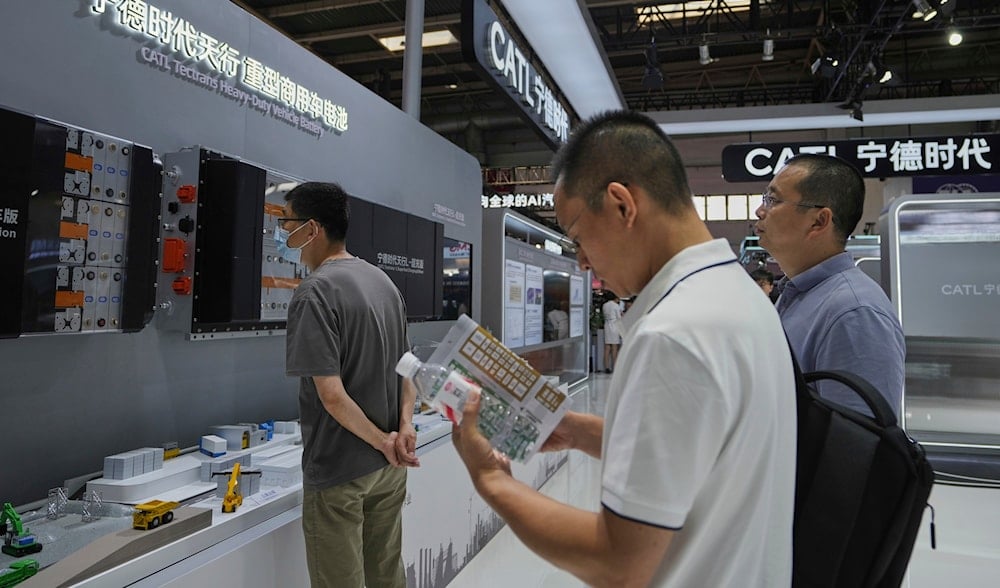AI boom sends China’s hardware stocks soaring
Investor excitement in AI-related stocks has been boosted by announcements from major global companies.
-

Visitors look at the batteries' components manufactured by Contemporary Amperex Technology Co, Limited (CATL) at the China International Exhibition Center, in Beijing, Thursday, July 17, 2025. (AP Photo/Andy Wong)
A group of Chinese hardware companies has become the strongest force in the A-share market this year, fueled by surging demand for computing power in artificial intelligence (AI).
Shares of Zhongji Innolight Co., Eoptolink Technology Inc., and Suzhou TFC Optical Communication Co. have all posted triple-digit gains, making them the top performers on China's main stock index. Their growth is tied to a rush of orders from AI data centers, which require optical transceivers, special devices that connect thousands of high-powered chips called graphics processing units (GPUs).
Investor excitement in AI-related stocks has been boosted by major global announcements. Nvidia Corp recently committed to investing $5 billion in Intel Corp and up to $100 billion in OpenAI, while Alibaba Group Holding Ltd pledged more than $50 billion to its own AI projects. These moves helped Chinese tech indexes surge, outpacing benchmarks like the Hang Seng Tech Index and the Nasdaq Composite Index.
Earlier this year, concerns about delayed Nvidia servers and skepticism over AI spending slowed the optical transceiver market, but demand picked up again in June as major cloud service providers raised their forecasts. According to CLSA analyst Tony Zhang, cited by Bloomberg, "stocks turned a corner in June" as the outlook for orders improved.
Why optical transceivers are key for AI growth
Optical transceivers are sometimes called the "signal translators" of AI data centers. They convert electrical signals into light signals and back again, allowing GPUs to communicate at extremely high speeds. As data centers scale up, each new GPU card requires additional transceivers, creating a multiplier effect for demand.
This demand surge has translated into strong earnings: second-quarter profits in the sector jumped 125% year-on-year, according to CSC Financial.
- Eoptolink’s stock has more than quadrupled, becoming the top performer on the CSI 300 Index in 2025.
- Innolight ranks second with a 235% jump.
- Suzhou TFC follows with a 166% gain.
Their performance has overshadowed other hyped stocks, including jeweler Laopu Gold Co. and AI chip designer Cambricon Technologies Corp.
Global tech giants drive orders
Global technology leaders are the biggest buyers of optical transceivers. More than half of Innolight's revenue comes from the so-called "Magnificent Seven" group of US tech giants, with Alphabet Inc alone contributing 36% of sales. Suzhou TFC counts Nvidia as a client, directly tying it to the AI hardware boom.
However, this reliance on international clients creates geopolitical risks. To reduce exposure, all three companies, Eoptolink, Innolight, and Suzhou TFC, have expanded production in Thailand to bypass US tariffs on China-made products.
Valuation concerns could slow momentum
Despite strong growth, some analysts warn that the sector may be overheating. The price-to-earnings (P/E) ratios of the three companies have all surpassed their five-year averages, raising concerns about sustainability.
Chris Liu, senior portfolio manager at Invesco Hong Kong, noted to Bloomberg that while growth potential remains, the recent gains "might not sustain in the short term" due to expensive valuations.
Liquidity could continue supporting the sector in the near term. Chinese households are sitting on trillions in excess savings, while margin financing, borrowing money to invest, has hit record highs.
Local equity funds have already increased their holdings in optical transceiver stocks. Meanwhile, foreign investors, who largely missed the early rally, are waiting for more favorable entry points, according to Liu.

 4 Min Read
4 Min Read









